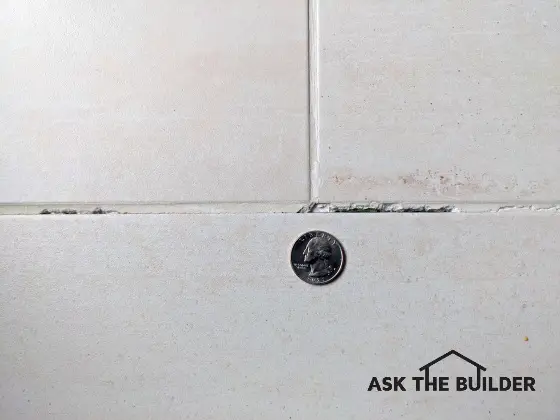How to Fix Cracked Grout on Tile Floor

How To Fix Cracked Grout on Tile Floor | This grout is less than two years old. It started to degrade less than six months after being installed. Copyright 2022 Tim Carter
Cracked Grout on Tile Floor
A few days ago, I was singing Happy Birthday for the third time to my granddaughter in the kitchen of her parent’s newer home. It was a festive morning and cake was served before lunch. After taking the first bite of the delicious cake my daughter made, I’m thinking this is a brilliant new trend many should consider!
Right behind and below my granddaughter was a section of grout in the tile floor that was defective. A significant amount of grout was missing from the joint. There are no less than ten or twenty other random places on the tile floor throughout the house where this exact same thing is happening.
When Was the House Built?
Days after my granddaughter was born, I was installing the cast-iron drain pipes in the house. Eighteen months later, it was move-in day. I was not the builder on the project but I did install all the plumbing, electric, and radiant heat in the home. Unfortunately, the builder lacked the skill set of how to order products in advance and schedule other subcontractors so there was activity on the job site every day. In my day, a simple rectangle custom house like my daughter’s would have taken me less than seven months to build from start to finish.
You can probably do the math, but the floor grout that failed is less than two years old. It started to fail within a month after my daughter moved in. There are quite a few reasons floor grout can fail, and based on where it’s failing in the house I’ve come to the conclusion it’s a simple workmanship error.
Do Wood Subfloors Cause Grout and Tile Cracks?
Your floor grout can crack if the floor itself flexes. Ceramic tile can be installed over a wood-floor system but it’s imperative the floor be as stiff as a granite countertop. In your lifetime you may have walked across a somewhat bouncy floor that felt a bit like a trampoline. These floor systems do meet minimum building-code requirements, but they’re death on a stick for ceramic tile flooring and grout.
My daughter’s home has a stiff floor. I made sure of this in the design. The two-story house is constructed using engineered floor trusses. In fact, the trusses under my granddaughter’s stool, while she was eating cake, were special extra-stiff ones made to compensate for the massive 10-foot by the 5-foot center island in the kitchen. There is absolutely no flex whatsoever in my daughter’s floors.

These are the floor trusses in my daughter's home. The floor I'm standing on to take the photo is also made from floor trusses. Copyright 2022 Tim Carter ALL RIGHTS RESERVED
Was the Actual Grout Defective?
Eliminating this possibility points the finger at the installer and possibly the actual grout itself. It’s easy to eliminate defective grout because a vast majority of the grout in the tile is fine with no defects. The floor was grouted over a period of a few days in the late spring of 2020.
How Does One Determine the Cause?
The random locations of the defects provide the insight to help determine the cause of the failure. Some are adjacent to bearing points of the floor trusses and others can be found mid-span of a few trusses. If the grout were failing just at mid-span you might make a compelling argument that the floor trusses have just enough flex to crack the grout.
But there’s a difference between when the grout just cracks and when it turns to powder and giant gaps and holes in the grout are present. This is the issue my daughter faces. The smoking gun, in my opinion, points to small amounts of grout that had already started to harden in the bucket and were applied by the tile setter. He may have even added a tiny amount of water to the stiff grout to make it workable.
How Do You Fix the Cracked and Missing Grout?
About ten years ago, I recorded with the help of my future son-in-law four in-depth videos showing exactly how to mix, install, and finish sanded floor tile grout so it can last for hundreds of years. Realize that floor grout is simply a miniature version of concrete and I can show you concrete in different parts of the USA that’s over 100 years old and has withstood decades of harsh weather. Your floor grout never has to experience this since it’s inside! You can watch the four videos at the bottom of this column. Keep reading, though!
The key to creating floor grout that lasts is controlling the water that’s used to mix it and the amount that’s used when you strike the joints with a sponge to make them look perfect. Keep in mind the instant you mix water with the dried grout you start an irreversible chemical reaction called hydration. Tiny crystals in the Portland cement in the grout start to grow. As more and more crystals grow, the grout gets stiff and eventually, it gets as hard as a rock. After all, all the components in standard sanded floor grout are all rock except for the water.
If the mixed grout in the bucket starts to get stiff because it wasn’t installed fast enough, there aren’t enough crystals left to bond to the sides of the tile in the actual grout joint. What’s more, if the installer decides to add a little water to make the grout workable, he breaks apart many of the crystal bonds that have already formed. These are not self-healing.
You can also ruin floor grout when you’re finishing the joints. The sponge that’s used to strike the joints must be just damp with all the excess water squeezed out before you slide the sponge across the floor tile and the grout lines. If excess water gets on the wet floor grout, it can dilute the amount of the Portland cement in the grout in those random areas where the water soaks into or puddles on the wet grout.
Column 1444